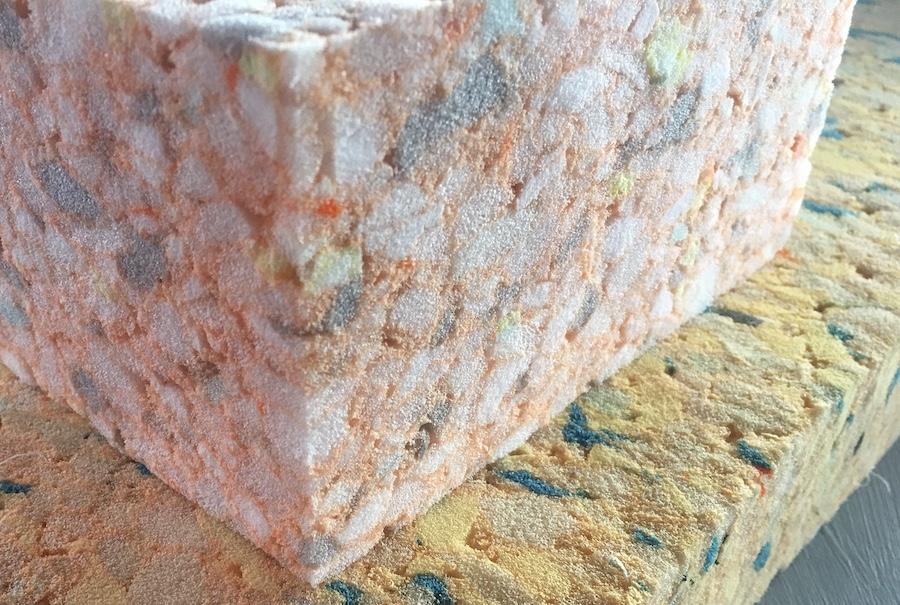You’ve probably used this foam lots of times in your home, or car, on a bus, or at the local bar. It’s everywhere – and mostly unseen. But what is rebond foam?
Here’s the guide on what rebond foam is, the common uses, how it’s made and the main features. But let’s start with a summary….
Rebond, also called recon or chip foam is made using recycled shredded scrap foam with leftovers of other foam. The foam scraps are mixed with liquid polyurethane to bind them and then compressed into a block. It has an open-cell structure and is known for its firm and durable properties.
What is Rebond foam and how is it made?
Rebond foam, as the name suggests, is a type of foam. It’s a more eco-friendly version of foam as it’s made from recycled shredded scrap foam (leftovers of different types of foam). This is a rather unique makeup compared to other types of foam.
Foam scraps are mixed with a liquid polyurethane which acts as a binder. This binds the scraps together and then compresses them into a block resulting in its firm shape.
Rebond foam has an open-cell structure and is renowned for its very solid and firm base that works well in holding its shape – thereby providing greater longevity.
Rebond Foam is one of the most versatile types of foam. This versatility has made the basic Rebond foam-making process include certain additives and other elements. This increases specific properties to make it more suitable for an application or purpose.
So be sure you specify the application for which you need Rebond foam, in order to get the best type to suit your purpose. Read more about density and firmness below.

Common uses
In general Rebond foam stands up to high impact/usage and can be used for applications that serve best for moderate to heavy residential and commercial uses.
Thick Rebond foams are popular for use in vehicle seating of good quality. Some of these include motorcycles, bus seats, tractors, and snowmobile seating.
Rebond foam also makes good use in house furniture, for furniture such as an ottoman, a window seat, or when you need something to substitute with expensive bean bags.
An ottoman made using Rebond foam can be used as a footstool as well. They are easy to move around from one place to another, firm enough that they can be used as a coffee table or even as occasional seating when you have extra guests.
They are used for bar seats and piano stools as well.
Rebond foam used in 1-inch thickness works well for exercise mats and sound proofing. 2-inch is ideal for weight benches, gym mats, massage tables. 3-inch for heavy use and greater comfort applications such as office chairs, bar and restaurant seating and automotive seating.
Carpet padding or cushioning also makes great use of Rebond foam. It provides the required comfort and durability to absorb foot traffic in carpets for many years. It can also be used for upholstery wall padding
Rebond foam serves many applications where a high level of firmness and robustness is required.
Rebond foam for outdoor use
Some foams on the market are ideal for outdoor use. Rebond foam is not considered one of them. It has an open-cell structure like Fast Dry foam, but one that is less porous and therefore holds more water. If used outdoors, it has to be tightly sealed to prevent water and moisture from penetrating.
Here are some ideas for the best foams to use outdoors.
Main features of Rebond foam
Here’s a rundown of the most outstanding features of rebond foam. Density and firmness are important factors for all types of foam.
Very high density
Rebond foam is well known for its remarkable density.
Generally, the density of Rebond foam will depend on its thickness, the greater the thickness the greater the density.
However, on average, Rebond foam has a density of 6 – 8 pounds per cubic foot. But this could go as high as 12 or 15 lb per cubic foot.
Higher ILD (Indentation Load Deflection)
This is a measurement that decides how much weight is required to create an indentation in the foam by 25% of it’s height.
A higher ILD implies a firmer foam than that of a lower ILD. On average Rebond foam has an ILD of 7.0 pounds.
Combined with the density to provide the crucial four numbers for foam, you might see something in the order of 6070. The first being the density rating, the second being the firmness.
Firmness and density are important ratings in foam that you should take into account – for any foam types. You can read more about density and firmness here.
Other features
Here are some other special features of Rebond foam that makes it stand out among other types of foam:
- Firm and supportive
- Resilient
- Lightweight
- Mildew and tear resistance
- Sound and shock absorbent
- High durability and longevity
- Versatile
- Generally less expensive but prices may vary depending on any special properties such as high density, high ILD or other resistant properties added to a basic Rebond foam.
Rebond foam color
Rebond foam typical comes in an even but multicolored set of colors. But as with most foams, rebond color is actually not important. The color is only dictated by the types of shredded foam used in the process at the time and has no bearing on it’s type.
Because of the unusual color in Rebond foam, it’s normally used in applications that will not be seen or uncovered, such as bar stools, for example.
Specifications for rebond foam
| Rebond Foam | |
|---|---|
| Quality | Excellent |
| Firmness (lb per cubic ft) | 7.0 lb |
| Structure | Open Cell |
| Density (range 1.0 – 6.0) | 5.0 – 6.0 (50 – 60) |
| Firmness (ILD) | 120 – 150 (supreme) |
| Lifespan | 12 years |
| Colors | Multicolored |
| Applications | Hospitality seating, bars, restaurants, etc, Gymnasium equipment, ATV’s, motorcycles, Snowmobiles, Industrial vehicle and machine seating, Carpet padding, Public transport, Wheelchair seats, Church kneelers |
More foam help
I hope this has helped answer your questions about “what is Rebond foam”. Be sure to check out my Firmness and Density article so you understand the main criteria foam is graded by.
